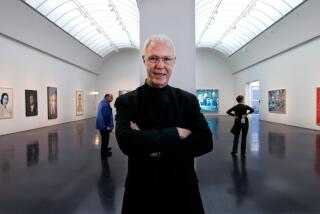Higher Learning: Steven D. Lavine to step down as president of CalArts
Decades before the digital revolution emerged in full force, Walt Disney Studios adapted new technologies for the first animated film to successfully synchronize sound and image in 1928’s “Steamboat Willie.”
Later, studio engineers developed a multi-channel sound system used in the 1940 animated film “Fantasia;” it was a precursor to surround sound.
Somewhere between Mickey Mouse and Steve Jobs, the idea of art melded with technology seemed to rupture, separating two cultures. Funding for arts education — music, dance, drawing — floundered, while science, technology, engineering and math —STEM education — flourished.
------------
FOR THE RECORD:
CalArts: In the June 24 California section, a column about the California Institute of the Arts said that the school launched a new arts education start-up, Kadenze. CalArts is a partner in the online program, but Kadenze is an independent company.
------------
But arts educators and technology chief executive officers are acknowledging once again that the two fields not only work hand-in-hand but that technological advances are often nourished by arts-inspired creative methods and critical thinking.
The connections recently were on the mind of Steven D. Lavine, president of the California Institute of the Arts, who announced Wednesday that he is stepping down from his post in 2017. Lavine will have spent 29 years at the helm of the Valencia-based private campus; it was envisioned by founder Walt Disney as a kind of Caltech of the arts.
Lavine has overseen a significant evolution in arts education and a big part of that change, he said, is the increasing interweaving of art and technology.
“CalArts from the first has embraced technology not as an enemy of the arts but as a tool of art,” Lavine said, noting that the school recently began offering a minor in digital arts, with such courses as computer programming, web design and digital sound production.
Such training not only opens new ways to create art and communicate with audiences, it also opens new career paths.
“Instead of having to be a waiter while launching their career,” Lavine said, “they can actually work in technology startups and make a decent wage while they go out and audition.”
Barely a week before Lavine’s announcement, the school launched a new startup, Kadenze, one of the first digital platforms for arts-focused education with online courses from campuses including Stanford, Princeton, UCLA and the Art Institute of Chicago.
Classes range from culture and art making and the history of modern and post-modern art to one using algorithms and software tools to create new musical instruments that respond to gestures.
“Before, there were two sides of the equation with engineers who knew a little bit about creativity and artists who knew a little bit about engineering,” said Ajay Kapur, who is CalArts’ associate dean for research and development in digital arts and a founder of Kadenze.
Now, Kapur said, art schools are breeding new “creative technologists” who will create “design experiences for the future of entertainment, games and storytelling.”
It was only a short while ago that arts education seemed the poor stepchild, with President Obama, legislators and academics urging action and funding to make up for American students’ shortcomings in science and math. Those concerns remain, but they also spawned the so-called STEM to STEAM movement (science, technology, engineering, arts and math) which seeks to couple science and math with art and design in lower and higher education.
“Very quickly people realized that without the context, the conceptional development and critical thinking that arts and design bring to the table, there was a huge loss of opportunity,” said Rosanne Somerson, president of the Rhode Island School of Design, which is a major promoter of STEAM.
Her school is now seeing many graduate-level students from the tech world who are using arts and design training to tackle global challenges, Somerson said.
Design students such as Sarah Pease, meanwhile, are gravitating to technology. Pease graduated in 2013 from the Rhode Island school, where she was a student STEAM leader, and is now the only designer at a San Francisco technology startup.
“Art most certainly has its place but I want to help people and see a direct outcome of my efforts, so I decided to come to Silicon Valley to help capitalize on those opportunities,” she said.
Meanwhile, a software firm chief executive officer recently joined the board of directors at the California College of the Arts, which has campuses in San Francisco and Oakland.
“In many ways, we’re partnering with those companies directly in co-curricular opportunities,” Provost Melanie Corn said. “Those companies are pulling from young design-focused minds and giving students a great connection.”
Rep. Jim Langevin (D-R.I.) introduced legislation that encourages the inclusion of art and design in federally funded STEM programs.
The National Science Foundation is funding programs such as the Art of Science Learning, an initiative that uses the arts to spark a more creative approach to tackling a variety of problems such as water resources in San Diego, urban nutrition in Chicago and transportation alternatives in Worcester, Mass. Teams use jazz improvisation, visual and spoken word poetry to help develop new ways of solving problems.
In his remaining two years, Lavine said, he will focus on fundraising for scholarships, transforming the school’s governing structure into one that is more transparent and further increasing diversity and CalArts’ reputation as a haven for international students. He confessed that he would love to start an engineering school but acknowledged that there are already great ones locally with which CalArts collaborates.
Still, the sentiment is an inheritance from that early adopter: Walt Disney, he said.
“Art in schools is an infallible way to release the creativity of students,” he said “and get them engaged in education.”
Twitter: @carlariveralat
More to Read
Sign up for Essential California
The most important California stories and recommendations in your inbox every morning.
You may occasionally receive promotional content from the Los Angeles Times.











